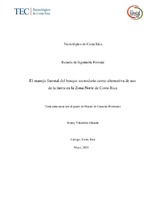| dc.contributor.advisor | Quesada-Monge, Ruperto | |
| dc.contributor.author | Villalobos-Chacón, Ronny | |
| dc.date.accessioned | 2020-10-29T16:05:18Z | |
| dc.date.available | 2020-10-29T16:05:18Z | |
| dc.date.issued | 2020 | |
| dc.identifier.uri | https://hdl.handle.net/2238/12237 | |
| dc.description | Proyecto de Graduación (Maestría en Ciencias Forestales) Instituto Tecnológico de Costa Rica, Escuela de Ingeniería Forestal, 2020. | es |
| dc.description.abstract | Los bosques secundarios tienen un gran potencial de manejo como generador de recursos y servicios para la sociedad. La producción de madera sigue siendo un recurso ampliamente utilizado y como una alternativa viable de acuerdo a las condiciones de mercado. El presente estudio se realizó en tres bosques secundarios de la región Huetar Norte Costa Rica, en las localidades de Florencia, Pénjamo de Florencia y Agua Zarcas. Estos bosques habían sido evaluados hace dos décadas y se les aplicó tratamientos silviculturales, sin embargo, nunca fue evaluado su efecto sobre la masa forestal, por tal motivo este estudio tiene con objetivo: evaluar el efecto de la aplicación de tratamientos silviculturales sobre especies comerciales. A partir de un muestreo diagnóstico y re-medición de parcelas permanentes se estimaron cambios por efecto de la aplicación de tratamientos en la composición florística, estructura horizontal y vertical, incrementos en volumen, área basal en especies comerciales y no comercial; así mismo, se evaluaron cambios sobre los líderes deseables sobresalientes, las estimaciones se compararon con el bosque testigo Florencia y Pénjamo solamente. El bosque que presentó lo mejores resultados atribuidos a los tratamientos silviculturales fue el estrato I bosque de Florencia, donde hubo un incremento de 66% sobre la abundancia de especies comerciales y un 86% sobre el área basal comercial comparado con el bosque testigo que solo reportó un 66% de su área basal comercial. Los tres bosques evaluados presentaron cambios satisfactorios en sus variables dasométricas, estructura y composición atribuidos al efecto sobre la aplicación de tratamientos silviculturales y su manejo previo, sin embargo, es importante volver a intervenirlos y monitorear su comportamiento de forma periódica con el fin de tener mejor validación de los resultados. | es |
| dc.description.abstract | Secondary forests have great management potential as a generator of resources and services for society. Wood production continues to be a widely used resource and as a viable alternative according to market conditions. The present study was carried out in three secondary forests of the Huetar Norte Costa Rica region, in the towns of Florencia, Pénjamo of Florencia and Agua Zarcas. These forests had been evaluated two decades ago and silvicultural treatments were applied, however, their effect on the forest mass was never evaluated, for this reason this study aims to: evaluate the effect of the application of silvicultural treatments on commercial species. From a diagnostic sampling and re measurement of permanent plots, changes were estimated due to the effect of the application of treatments in the floristic composition, horizontal and vertical structure, increases in volume, basal area in commercial and non-commercial species; Likewise, changes on the outstanding desirable leaders were evaluated, the estimates were compared with the control forest Florencia and Pénjamo only. The forest that presented the best results attributed to silvicultural treatments was stratum I forest of Florencia, where there was an increase of 66% on the abundance of commercial species and an 86% on the commercial basal area compared to the control forest that only reported 66% of its commercial basal area. The three evaluated forests presented satisfactory changes in their dasometric variables, structure and composition attributed to the effect on the application of silvicultural treatments and their previous management, however it is important to intervene again and monitor their behavior periodically in order to have better validation From the results. | en |
| dc.language.iso | spa | es |
| dc.publisher | Instituto Tecnológico de Costa Rica | es |
| dc.rights | acceso abierto | es |
| dc.subject | Manejo forestal | es |
| dc.subject | Bosque secundario | es |
| dc.subject | Uso de la tierra | es |
| dc.subject | Aprovechamiento forestal | es |
| dc.subject | Lideres | es |
| dc.subject | Tratamiento | es |
| dc.subject | Silvicultura | es |
| dc.subject | Producción forestal | es |
| dc.subject | Manejo de bosques | es |
| dc.subject | Composición florística | es |
| dc.subject | Forest management | en |
| dc.subject | Secondary forest | en |
| dc.subject | Land use | en |
| dc.subject | Forest use | en |
| dc.subject | Leaders | en |
| dc.subject | Treatment | en |
| dc.subject | Floristic composition | en |
| dc.subject | Research Subject Categories::FORESTRY, AGRICULTURAL SCIENCES and LANDSCAPE PLANNING | en |
| dc.subject | Forest harvesting | en |
| dc.subject | Silvicultural treatments | en |
| dc.title | El manejo forestal del bosque secundario como alternativa de uso de la tierra en la Zona Norte de Costa Rica | es |
| dc.type | tesis de maestría | es |


